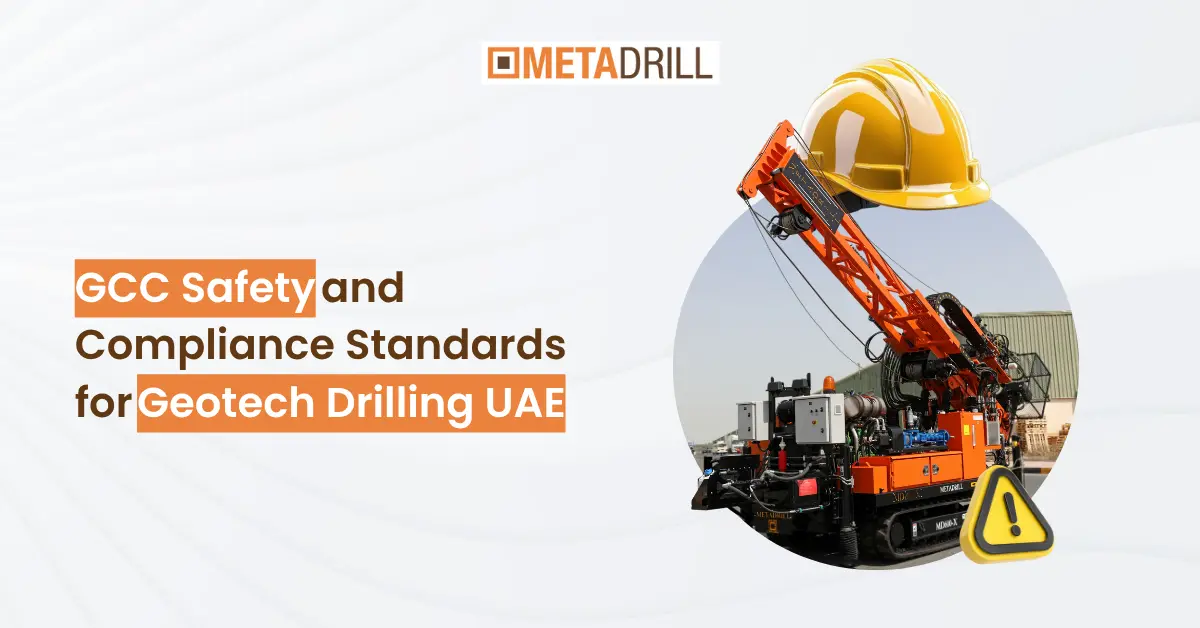
Safety in geotech drilling is not optional, it’s engineered. UAE and GCC projects expect geotechnical drilling rigs to meet machine-safety standards, follow sampling rules, and operate under local HSE controls. This guide maps the core standards, field practices, and documentation your team needs so every drill rig shift is compliant, consistent, and defensible.
BS EN 16228 (drilling & foundation equipment safety). BSI Knowledge
Construction accounts for about 30% of all occupational fatal injuries worldwide, a reminder that controls around people, machines, and methods truly matter.
Build on Standards, Not Assumptions
The big three you should know
BS EN 16228 (Parts 1–7): safety requirements for drilling/foundation machines, guards, interlocks, emergency stops, control systems, and stability. Use Part 1 with the machine-specific parts that apply to your geotechnical drilling rigs.
ISO 22475-1: technical principles for sampling soil/rock and groundwater; defines how you take, preserve, and document samples so data from drilling tools is defensible.
Abu Dhabi/QCC geotechnical guidance & OSH codes: risk-led investigation and drilling controls (e.g., codes for well construction; manuals on managing geotechnical risk) that project teams in the UAE should fold into method statements.
Machine Safety: What “Good” Looks Like on a Rig
Make the rig safe by design
Guarding & interlocks: Rotating parts, feed systems, and rod-handling zones on Metadrill drilling rigs should be guarded with interlocks that stop motion when opened (aligned to EN 16228).
Emergency stops & controls: E-stops reachable from operator and offsider positions; controls labelled and directionally consistent across your fleet of geotechnical drilling equipment.
Stability & setup: Level the drill rig, verify outrigger loads and ground bearing; record pre-shift stability checks in the TBT (toolbox talk) log.
Electrical & hydraulic discipline
Hydraulics: Color-coded Hose Tagging, spill plans, tagging, and pressure tests; secure lines on walkways; lock-out before cutting any circuits in Geotechnical drilling equipment.
Electrical Protection: IP-rated enclosures, dust control, GFCI/RCD security; cabinet doors locked with no wires ad-hoc.
People & Process: Control the Work, Not Just the Machine
Role clarity keeps crews safe
Supervisor (permit holder): owns the method statement and stop-work authority.
Lead driller: runs the panel, enforces exclusion zones on Metadrill geotechnical drilling sets.
Offsider: handles drilling tools, housekeeping, and sample chain-of-custody.
HSE: audits compliance with EN/ISO references and site rules.
Exclusion zones & communication
Paint and sign the rotation envelope; use spotters during rod moves.
One radio channel for commands; repeat-back protocol at every critical step on geotech drilling tasks.
Sampling & QA/QC: Compliance That Protects Your Data
Do the boring things right (ISO 22475-1)
Plan the sample set: depths, intervals, and types (SPT, Shelby, core) before mobilization.
Preserve and label: liner choice, temperature control, water-tight seals, and legible IDs; photograph core boxes.
Document everything: recovery, RQD, refusals, groundwater levels; maintain a chain-of-custody form that travels with the sample, non-negotiable on geotechnical drilling rigs.
Tooling that supports quality
Match bit/crown to formation; inspect barrels, shoes, and rods each run; retire damaged drilling tools promptly.
Calibrate torque, RPM, and pressure sensors; keep certificates in the rig QA folder.
Local Compliance: UAE/GCC Expectations in Plain English
Permits, permits, permits
Confirm work permits, buried-services clearances, and traffic plans before the first rod lifts.
In Abu Dhabi, align with OSH codes (e.g., well construction CoP) and geotechnical risk manuals; your geotechnical drilling company should reference these in method statements.
Environmental & community controls
Dust and noise management, fluid containment, and safe waste handling, especially on urban pads where Metadrill drilling rigs often operate.
Public interface plans: barriers, banksmen, and clear signage around the drill rig.
Practical Field Checklist (Shift-Ready)
Before you spin the rods
Pre-start with EN 16228 guard/interlock checks; verify E-stops.
Confirm sampling plan (ISO 22475-1) and label sets; stage spare drilling tools.
Test comms; brief exclusion zones; sign the TBT sheet.
During the run
Keep hands clear of rotating gear; use handling aids; maintain housekeeping.
Log parameters (RPM, torque, feed, pressure) and groundwater observations.
After the run
Photograph core; reconcile IDs; hand off to lab with intact paperwork.
Close out the permit and housekeeping; inspect guards and hoses for the next shift.
Why this rigor matters in 2025
The GCC construction market reached USD 147.1 billion in 2024 and is projected to hit USD 226.2 billion by 2033 (4.9% CAGR), a scale that demands consistent, standards-led site practice on every geotech drilling job.
You can also check: Rig Refurbishment Playbook: Extend Life and Cut Downtime ROI
Conclusion: Make Standards Your Competitive Edge
Treat standards as operating tools, not paperwork. Anchor machine safety to BS EN 16228 and sample integrity to ISO 22475-1; write local permits and risk controls into every method statement; and keep roles, zones, and documentation tight. Do that, and your geotechnical drilling rigs will run safer, your drilling tools will produce defensible data, and your clients will trust Metadrill geotechnical drilling as a partner. Standards-led geotech drilling turns risk into routine, shift after shift with Metadrill drilling rigs and compliant geotechnical drilling equipment.
Question to the public:
UAE/GCC geotech drilling safety: BS EN 16228 machines ISO 22475-1 sampling, HSE permits. Operate compliant rigs, protect crews, deliver defensible data.